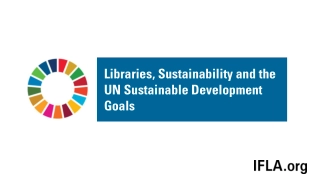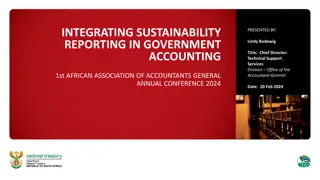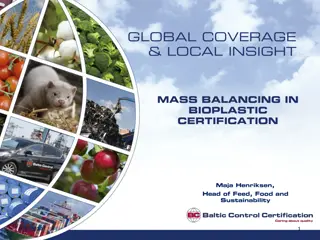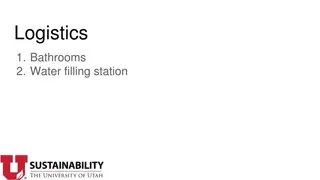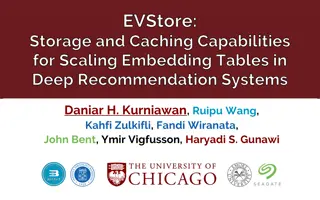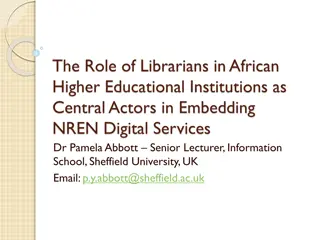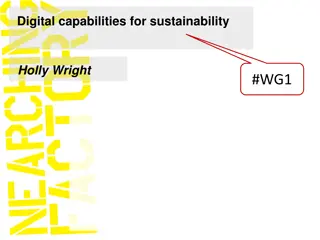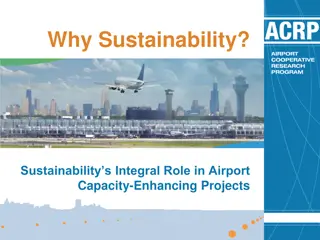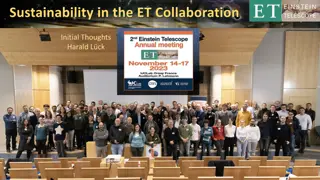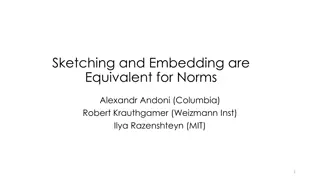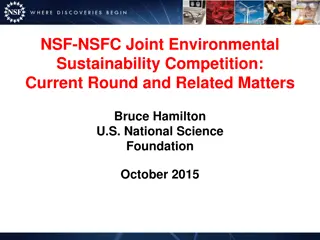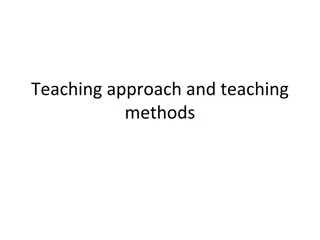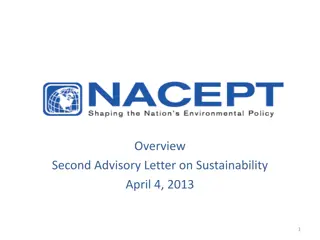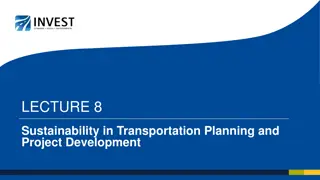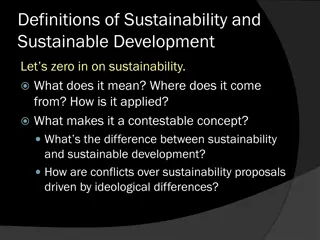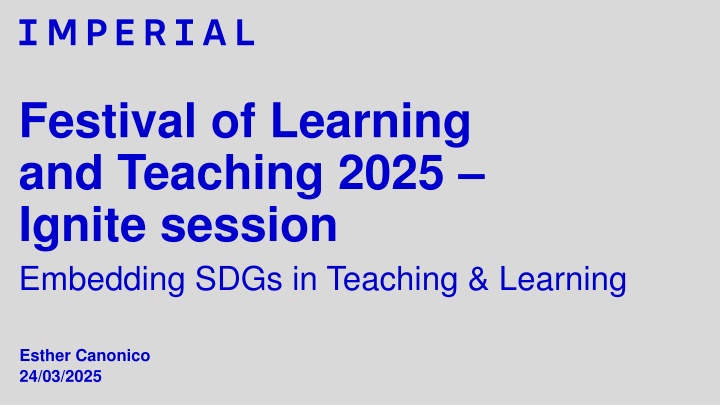
Integrating Sustainability in Teaching and Learning at Imperial College London Festival 2025
Explore the integration of Sustainable Development Goals (SDGs) in teaching and learning, uncover barriers faced by academics, and discover the process of embedding sustainability in education. Dive into current mapping efforts utilizing AI to evaluate teaching scores and examples of SDGs addressed in Business Economics and Climate Change modules.
Download Presentation

Please find below an Image/Link to download the presentation.
The content on the website is provided AS IS for your information and personal use only. It may not be sold, licensed, or shared on other websites without obtaining consent from the author. If you encounter any issues during the download, it is possible that the publisher has removed the file from their server.
You are allowed to download the files provided on this website for personal or commercial use, subject to the condition that they are used lawfully. All files are the property of their respective owners.
The content on the website is provided AS IS for your information and personal use only. It may not be sold, licensed, or shared on other websites without obtaining consent from the author.
E N D
Presentation Transcript
Festival of Learning and Teaching 2025 Ignite session Embedding SDGs in Teaching & Learning Esther Canonico 24/03/2025
What are the sustainable Development Goals? Overview 12/04/2025 Imperial College London Festival of Learning and Teaching 2025 2
Integrating sustainability in teaching and learning What are some the barriers that academics face? Limited understanding of sustainability and the SDGs Time constraints and workload pressures Lack of guidance or institutional support Uncertainty about relevance to their discipline Assessment and curriculum design challenges Imperial College London Festival of Learning and Teaching 2025 12/04/2025 3
How to integrate sustainability in teaching & learning? Process Review your module or curriculum to assess how these goals are currently addressed. This could involve: mapping existing content against relevant SDGs spotting gaps and explore opportunities for further integration (e.g., new case studies, activities, guest speakers, etc.) A live process - a continuous loop of reflection, experimentation, and iteration. Imperial College London Festival of Learning and Teaching 2025 12/04/2025 4
Current mapping efforts using AI Example 1: Method The prompt given is Provide a relative SDG Teaching Score (1 10) based on: Breadth of SDG coverage: Number of SDGs meaningfully addressed. Depth of SDG integration: Quality and relevance of the SDG teaching. Effectiveness of pedagogy: Impact of activities, discussions, and resources related to SDGs. We also ask ChatGPT how to improve the score, and what are the basis elements justifying the score. Imperial College London Festival of Learning and Teaching 2025 12/04/2025 5
Current mapping efforts using AI Example 1: Results Business Economics, Climate Change and the Environment Description: Provides a foundational understanding of how business economics interrelates with climate change and environmental challenges. Key SDGs Addressed: SDG 13, SDG 8 Strengths Focus on economic strategies to address environmental challenges. Offers practical applications of business frameworks to sustainability issues. Areas for Improvement Expand case studies on global environmental policies. Include regional economic analyses related to climate change. Imperial College London Festival of Learning and Teaching 2025 12/04/2025 6
Current mapping efforts using AI Example 2: Method AI Extraction instructions Extract content from educational materials that shows clear, explicit connections to UN Sustainable Development Goals (SDGs). For each potential quote: Content MUST: 1. Show clear, explicit connection to SDGs - not general academic concepts 2. Be 2-3 sentences minimum of verbatim text 3. Demonstrate specific sustainable development context . ai_summary_instructions Provide a concise paragraph that: 1) Identifies the 2-3 most prominent SDG themes found in the content, backed by frequency counts, 2) Notes any obvious gaps by identifying 1-2 missing or underrepresented SDGs that could naturally fit the material's context SDG prompt here Imperial College London Festival of Learning and Teaching 2025 12/04/2025 7
Current mapping efforts using AI Example 2: Results The content predominantly focuses on two Sustainable Development Goals (SDGs): "8 - Decent Work & Economic Growth" with 9 mentions, and "3 - Good Health & Well- being" with 4 mentions. These SDGs emphasize promoting fair labor practices, job security, and employee well-being. There is also a notable reference to "10 - Reduced Inequalities" with 2 mentions, highlighting the importance of workplace diversity and inclusion. An observed gap is the underrepresentation of "5 - Gender Equality," which could be naturally incorporated given the context of workplace dynamics and inclusion. To integrate this SDG, the content could include discussions or case studies on gender parity initiatives within organizations, focusing on equal opportunities and representation for all genders. Imperial College London Festival of Learning and Teaching 2025 12/04/2025 8
Current efforts using AI Benefits and Limitations of this approach Limitations? Benefits? Rely on clear and specific links to SDG themes Do not capture in-class experiences, such as discussions Analyses learning materials in isolation Does not incorporate UNESCO guidelines A relatively quick approach simply requires providing relevant materials Offer clear guidance Practical and easy to implement Imperial College London Festival of Learning and Teaching 2025 12/04/2025 9
Addressing limitations Using UNESCO Framework Why the UNESCO framework? UNESCO is the United Nations specialised agency for education. It leads and coordinates the Education 2030 Agenda It guides on how to use education in achieving the SDGs: o identifies learning objectives o suggests topics and learning activities for each SDG o describes implementation on different levels from course design to national strategies. This framework is not prescriptive in any way - provides guidance and offers suggestions for learning topics and objectives that educators can select and adapt to fit concrete learning contexts. 12/04/2025 Imperial College London Festival of Learning and Teaching 2025 10
Why using UNESCO Framework? It describes specific learning objectives for all SDGs. For each SDG, learning objectives are described in the cognitive, socio-emotional and behavioural domains: The cognitive domain comprises knowledge and thinking skills necessary to better understand the SDG and the challenges in achieving it. The socio-emotional domain includes social skills that enable learners to collaborate, negotiate and communicate to promote the SDGs as well as self-reflection skills, values, attitudes and motivations that enable learners to develop themselves. The behavioural domain describes action competencies. Additionally, for each SDG, indicative topics and pedagogical approaches are outlined. UNESCO framework 12/04/2025 Imperial College London Festival of Learning and Teaching 2025 11
Process This process is designed to help you explore ways to integrate SDGs into your teaching. Step 1: Map your work against UNESCO framework to identify relevant areas for integration. Step 2: Develop new activities that engage students and foster sustainability-related skills. Step 3: Adopt pedagogies and assessments that enhance both cognitive and affective learning. Step 4: Leverage opportunities within Imperial to foster and support sustainability initiatives. 12/04/2025 Imperial College London Festival of Learning and Teaching 2025 12
Step 1: Mapping process for a module Break down the module material into content areas with common learning objectives. Each content area may encompass a combination of learning material such as presentation slides, relevant readings, group and whole-class discussions, in-class exercises, or self-reflection activities. Briefly explain the learning objectives for each content area. Identify how the learning objectives for each area is related to one of the SDGs. Consider learning objectives in cognitive, socio-emotional and behavioural domains following guidelines by UNESCO. 12/04/2025 Imperial College London Festival of Learning and Teaching 2025 13
Step 1: Mapping process of a module Relevant SDG Content Area / LO LO related to SDG Components Slides, Readings, Activities, Discussion, etc Content Area 1 / LO Relevant SDG Specific aspect Learning objectives related to SDG Slides, Readings, Activities, Discussion, etc Content Area 2 / LO Relevant SDG Specific aspect Learning objectives related to SDG Relevant SDG Specific aspect Learning objectives related to SDG Slides, Readings, Activities, Discussion, etc Content Area 3 / LO 12/04/2025 Imperial College London Festival of Learning and Teaching 2025 14
Example: Organisational Behaviour module Course material / activity LOs Content area / Relevant SDG(s) Learning objectives related to SDGs Presentation slides, relevant readings, group and whole- class discussions, and a formative quiz to assess knowledge and understanding. Week 1: Decision- making. Develop an awareness of key cognitive biases that influence individual decision-making and learn practical strategies to mitigate them in professional and everyday contexts. Cognitive: Define key cognitive biases (e.g., confirmation bias, anchoring bias, availability heuristic, overconfidence bias) and explain their impact on individual and group decision-making. Analyse how cognitive biases influence workplace practices, such as hiring, performance evaluations, and leadership decisions. Identify evidence-based debiasing techniques, including structured decision-making frameworks, data-driven analysis, and accountability mechanisms. Socio-emotional: Develop self-awareness to recognize personal biases and how they shape perceptions and interactions. Cultivate empathy and perspective-taking to understand the impact of biased decisions on diverse individuals and groups. Strengthen critical thinking and ethical reasoning to assess decision-making processes more objectively. Foster open-mindedness and cognitive flexibility, encouraging receptiveness to different perspectives and constructive feedback. SDG 4: Quality Education Promoting critical thinking and informed decision-making. SDG 5: Gender Equality Addressing biases that affect hiring, leadership, and workplace interactions. SDG 8: Decent Work and Economic Growth Encouraging fair and ethical decision-making in professional settings. SDG 10: Reduced Inequalities Recognizing and mitigating biases that contribute to systemic discrimination. Behavioural: Apply debiasing strategies in real-world scenarios. 12/04/2025 Imperial College London Festival of Learning and Teaching 2025 15
Next steps in process Once mapping is completed: Step 2: Develop new activities that engage students and foster sustainability-related skills. Step 3: Adopt pedagogies and assessments that enhance cognitive, affective and behavioural learning Step 4: Leverage opportunities within Imperial to foster and support ESD initiatives. 12/04/2025 Imperial College London Festival of Learning and Teaching 2025 16
Thank you 12/04/2025 Imperial College London Festival of Learning and Teaching 2025 17


